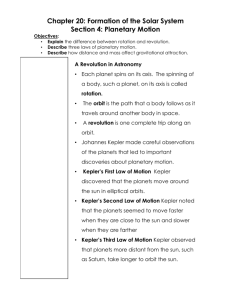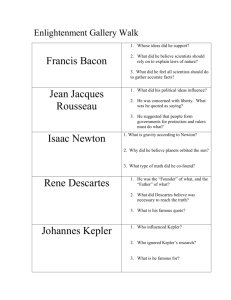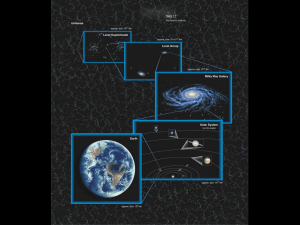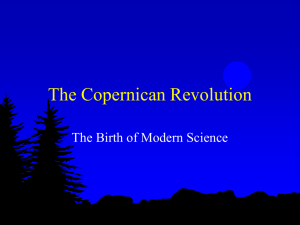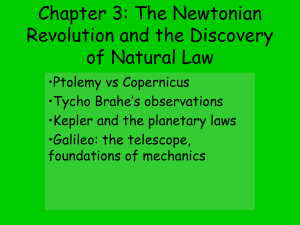Science and Astronomy - Historical Perspective
advertisement
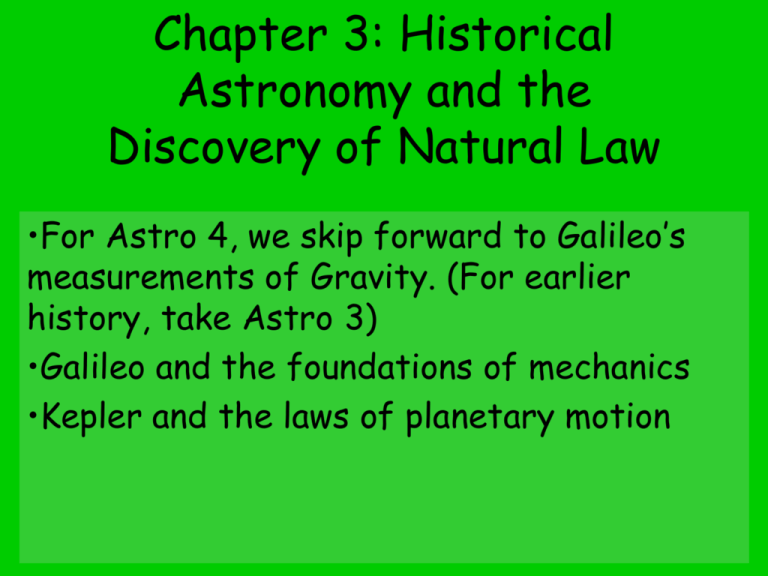
Chapter 3: Historical Astronomy and the Discovery of Natural Law •For Astro 4, we skip forward to Galileo’s measurements of Gravity. (For earlier history, take Astro 3) •Galileo and the foundations of mechanics •Kepler and the laws of planetary motion Interesting - Aristarchus in ~600BC first deduced the planets orbited the sun, not the Earth • His reasoning is not known – original writings were lost when the great Library of Alexandria was burned by religious zealots • The Greeks had no authoritarian religious problem with a sun-centered universe. But, • They reasoned if the earth orbited the sun we should see parallax motion in the stars. • They didn’t, and so thought the earth must be at the center… unfortunate decision, as luck would have it. The Rise of the Church • Ptolemy introduced his Earth-centered model at the time of the rise to power of the Christians in western civilization. • The Earth-centered model was in line with their belief that the Earth is the center of God’s universe and God’s attentions. It became dogma… to be challenged only at the risk of being “reeducated” in the dungeons of the Inquisition • Fear is a bad ingredient to introduce into the quest for knowledge. Progress… stopped. There followed 1,500 years of intellectual stagnation – or worse – in the West • In the 1550’s Nicholas Copernicus challenged the Church with his realization that the motions of the planets could be understood much more simply if all planets revolved around the sun… Giordano Bruno • Astronomer, mathematician, and poet of the late 1500’s, Bruno openly advocated the idea that the stars were sun’s like ours, likely with planets which had life. Brilliantly insightful for that early time! • How was he rewarded? Imprisoned for 8 years by the Catholic Church, tried by the Inquisition, and burned at the stake in 1600, in Italy. • Very tough to get good science done in this environment… this is the environment in which Galileo found himself. Was it just a matter of symantics as to who got to be called “the center of the solar system?” • Or, is there an observational test which rules one way conclusively? • Enter… Galileo Galileo’s Telescopic Discoveries • Heard about the invention of the telescope by Hans Lippershey in 1610, and immediately ground his own lenses and built the first astronomical refracting telescope. • Got him into MAJOR trouble with the Catholic Church, which pretty much ruled western civilization at this time and for a millenium prior. • He looked through his telescope and saw… Bottom Line: Galileo’s Observations Show that Venus’ path must have the Sun inside of it, and the Earth must be outside of Venus’ orbit. This is contrary to the Ptolemaic Model • Still, Galileo had been a friend of the man who later became Pope for many years, and this gave him certain shelter from the wrath of the Church. • But Galileo’s masterful and devastating critique of Jesuit positions on science alienated that large segment of the Catholic Church, and when the political position of Pope Urban weakened, Galileo was sent to the Inquisition and threatened with torture if he did not recant his scientific positions. • At his trial in 1633, under threat of torture, he proclaimed he rejected these scientific positions. The Inquisition was not impressed, sentenced him to prison, later commuted to house arrest, where he spent the remainder of his life. • All of his works, including any he might write in the future, were declared officially banned. But it was too late to stop the Renaissance in science • Copernicus’ “De Revolutionabus” in 1543 had become an underground hit! • Now the race was on – perfect uniform circular motion, even in the sun-centered model, didn’t reproduce the measured positions of the planets accurately. • What is the true shape and true motion of the planets? To answer, we first need GOOD DATA! • Enter… Tycho Brahe Tycho Brahe – Danish Astronomer of late 1500’s • Discovered the supernova of 1572, showed it was far beyond the planets – the first non-planet to be shown to be something other than fixed and constant. • King of Denmark impressed, gave him an island and money to build the best scientific instruments of his day • He read Copernicus, his goal: find the true orbits of the planets. • He was an OUTSTANDING observer. Measured the precise positions of the planets, especially Mars, every clear night for 20 years, with an accuracy of +- 1 arcminute (!) • But he was a mediocre mathematician. No problem – he had the money – he hired a good one! Kepler picture How did Kepler determine the shape of the planetary orbits? He was Very Clever! • Kepler’s data was a table of times and positions of the planets. • He figured, let’s start with a promising planet and once we’ve figured it out we can then streamline the work on the other planets. • Let’s try and decide which would be a good choice for a first planet to tackle… Kepler’s st 1 Law • Planets orbits in ellipses, with the sun at one focus • Like this… Kepler’s st 1 law Drawing an ellipse Kepler’s nd 2 Law • The sun-to-planet line sweeps out equal areas in equal times • Often called the “Equal Area Law” • Pick any time interval you want. The sunplanet radius sweeps through the same area during that time interval, regardless of where it is in the orbit. • Said another way – the rate at which the sun-to-planet line sweeps out area, is constant throughout the orbit. Kepler’s nd 2 law An Animation showing the Meaning of Kepler’s 2nd Law: “The Sun-to-Planet Line Sweeps Out Equal Areas In Equal Times” • http://en.wikipedia.org/wiki/File:Kepler-secondlaw.gif • And a YouTube 9 sec video • And a tune-able animation • This law is an example of a more general rule – Conservation of Angular Momentum AngMom definition The Meaning of Angular Momentum • Imagine something moving around an orbit, or if its rotating. • Now imagine how much work you’d have to do to STOP that spinning. That’s a good feel for the amount of its Angular Momentum. Kepler’s rd 3 Law • Kepler found after he’d determined the orbits of all the 5 planets known then, that the larger the orbit, the longer it took to orbit the sun. • He asked – is there a simple, quantitative law that describes this? He searched… • Size of the orbit? There’s many ways one might try and quantify the size of an orbit. List some for me, gang!..... Here’s a Few… • • • • • • • Circumference of the orbit Sqrt(area of the orbit) Longest diameter Shortest diameter Sqrt(long * short diameters) Time averaged distance to the sun Spacial averaged distance to the sun Kepler Tried Many and Found No Pattern, Until… • … he tried the following… • (Period)2 = K a3 • Where a = semi-major axis = half the longest diameter of the orbit, and period is how long it takes to go around the sun • What about K? K is a dimensional constant • Consider Dimensions vs. Units… Soon we’ll See how Newton Derived Kepler’s Laws from pure deduction from his laws of motion and of Gravity • We’ll see that this little law – Kepler’s 3rd law… P2 = Ka3 • …Turns into what is probably the single most useful and valuable equation in all of astronomy. A story to be continued in the next slide show….

